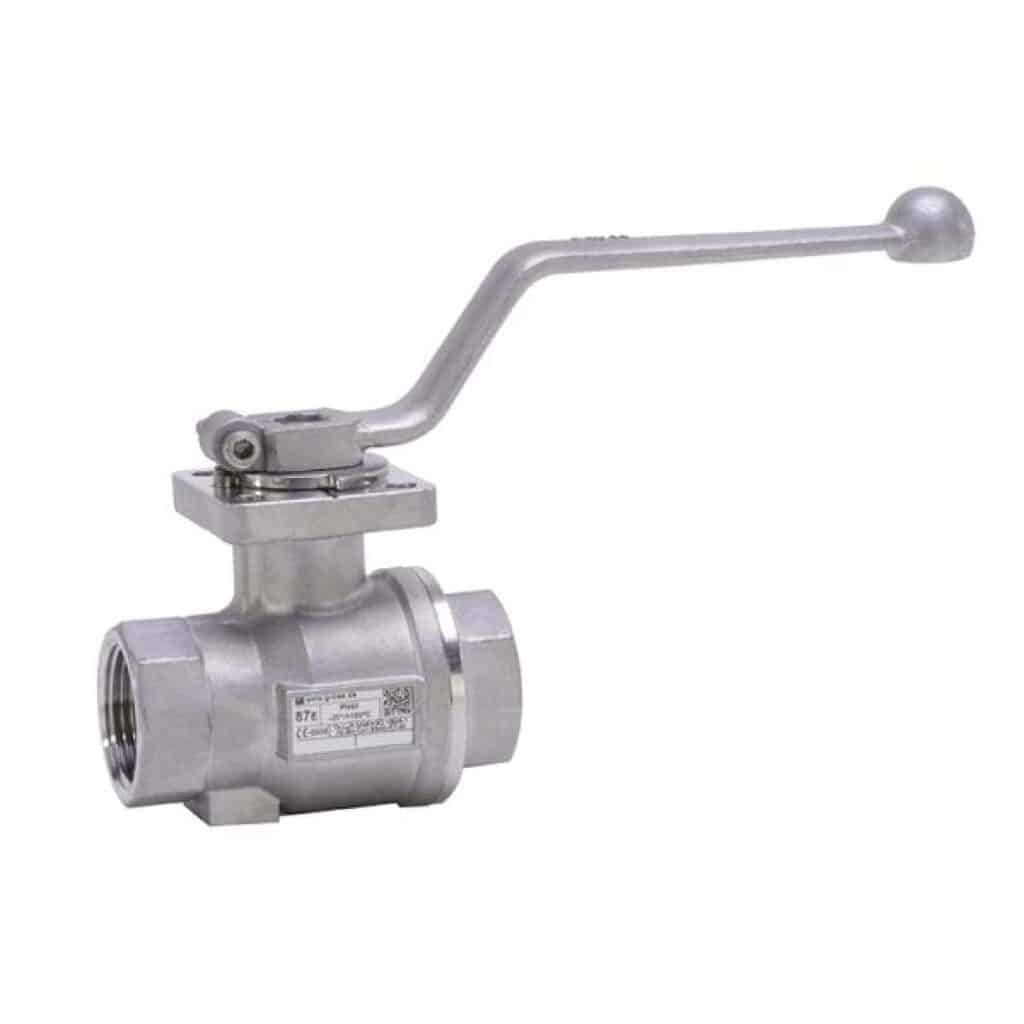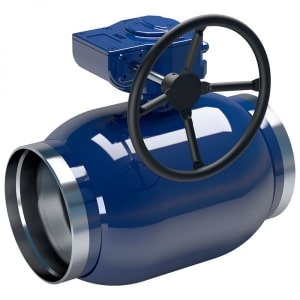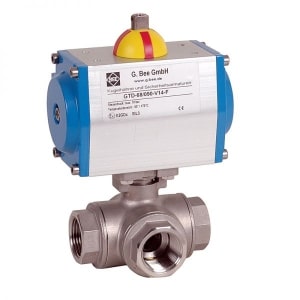Ball valves
Our range of ball valves from G. BEE GmbH is now available in our online shop!
Startseite » Fluid Technology » Ball valves
A ball valve is a shut-off valve that controls the flow of liquids or gases using a rotating ball with a bore. By rotating the ball 90 degrees around its axis, the ball valve can allow or block the flow of the media. Ball valves are known for their long service life and provide reliable sealing throughout their usage, even when the valve is not used for an extended period. This makes them a preferred choice for shut-off applications compared to, for example, gate valves. Ball valves are more resistant to contaminated media than most other types of valves. In certain variations, ball valves are also used as control valves. This application is less common as the flow control capability is relatively limited compared to other types of control valves. However, the valve still offers some advantages in this regard. For example, it ensures reliable sealing even with contaminated media.
The operating principle of a ball valve is as follows:
To understand the operating principle of a ball valve, it is important to be familiar with its five main components and the two different operating modes. The five main components include the valve stem, which is connected to the ball and is operated either manually or automatically (electrically or pneumatically). The ball is supported and sealed by the ball valve seat and the O-rings around the valve stem. All of these parts are housed inside the valve body. The ball has a bore that is either opened for flow when the valve stem is rotated by a quarter turn or closed to prevent any medium from flowing through.

Functionality
Ball valves can have two, three, or even four ports, depending on their design (2-way, 3-way, or 4-way). Most ball valves are designed as 2-way valves and are manually operated with a lever. When the valve is open, the lever is in line with the pipe. In the closed position, the handle is perpendicular to the pipe. In a 2-way valve, the flow simply goes from the inlet side to the outlet side. Manually operated ball valves can be closed quickly, which can cause water hammer in rapidly flowing media. Some ball valves are equipped with a gearbox. 3-way valves have an L or T-shaped bore that affects the flow path. This allows for various circuit applications, such as distribution or mixing of flows.
Manual Ball Valves
A manual ball valve is operated by rotating the handle 90 degrees, which is why they are also referred to as quarter-turn valves. The handle is directly connected to the ball stem. When the handle direction is parallel to the connection pipe or hose, the ball valve is open, allowing the medium to flow from the inlet through the bore to the outlet. When the handle direction is perpendicular to the connection pipe or hose, the valve is closed, blocking the flow of the medium. This makes it easy to determine whether a two-way ball valve is open or closed.
Hand-operated ball valves are one of the most commonly used valves due to their simple operation, reliability, long lifespan, and versatile applications. Manual ball valves are available as either 2-way or 3-way valves. In manual 2-way ball valves (shut-off valves), there are two ports: an inlet and an outlet. The valve opens or closes to direct or stop the flow of the medium from one port to the other. Manual 3-way ball valves have three ports. The bore in the ball is not straight but rather L or T-shaped. 3-way valves allow for distribution, mixing, or diverting of the flow in the desired direction.
Automatic Ball valves
Instead of manually operating the handle to open and close the valve, some valves can be equipped with an electric or pneumatic actuator. These actuators are directly connected to the valve stem and enable a quarter-turn motion of the valve. The most common flange connection between the valve and actuator is according to the ISO 5211 standard. By using an actuator, the ball valve can be remotely controlled or controlled by a controller, allowing it to function as an automatic shut-off valve. A spring-actuated ball valve, also known as a spring-loaded ball valve, uses a spring to open or close the valve in the absence of power, while the actuator holds it in the open or closed position. This type of ball valve is used for energy savings or for operational safety reasons.

How can the actuation be controlled in automatic ball valves?
- In a 2-point control, also known as On-Off or Open-Close control, a control wire is used in addition to the power cables. When the control wire is energized, the valve opens electrically. If the control wire is not energized, the valve closes either electrically or due to the action of a spring.
- A 3-point control utilizes two separate control wires: one for rotating the ball clockwise and one for rotating the ball counterclockwise. Depending on the requirements of the application, the appropriate control method can be selected.

Brass Ball Valve
Brass has the largest market share. Brass is an alloy of copper and zinc and possesses excellent mechanical properties. Brass valves are used for various media such as (potable) water, gas, oil, and air. When using solutions containing chlorine, such as seawater or demineralized water, there is a risk of dezincification. Dezincification is a form of corrosion where the zinc is leached out of the alloy, resulting in a porous structure with significantly reduced mechanical strength. A brass housing is ideal for an air ball valve.
Stainless Steel Ball Valve
Stainless steel is used for corrosive media and in aggressive environments. Therefore, they are commonly used in applications such as seawater, swimming pools, reverse osmosis systems, elevated temperatures, and various chemicals. Most stainless steels belong to the austenitic group. The most common variants are Type 304 and 316, with the latter having the best corrosion resistance. Type 304 is sometimes referred to as 18/8 because it contains 18% chromium and 8% nickel. Type 316 contains 18% chromium and 10% nickel (18/10). Stainless steel valves typically require higher operating torque compared to brass or PVC valves. This should be taken into consideration when using an electric or pneumatic actuator for a stainless steel valve.

Purchase G. BEE GmbH ball valves at PACH Systems.

Gas ball valve with threaded connection
- Blowout-proof stem
- Thread according to DIN EN 10226-1
- Marking according to EN 19
- Silicone-free
- Full bore according to DIN EN 1983
- Standard temperature range from -20°C to +60°C
- Pressure rating: MOP5
- Approval text: DVGW Gas Approval MOP5 according to DIN EN 331 and DIN 3586 C5 GT5, DVGW Approval according to Gas Appliances Regulation GAR EU-2016-426, DVGW Approval Gas thermally resistant up to 650°C, classified according to PED Category 3 PED 2014-68-EU, LABS compliant according to VDMA 24364.

District heating ball valve made of steel with manual gearbox
- Maintenance-free
- Blow-out proof stem
- Floating ball
- Reduced bore
- Connections according to DIN 2353
- Silicone-free
- Suitable for district heating, compressed air, general water applications, heating circuits, water-glycol mixtures, oil, thermal oil, Tyfocor
- Standard temperature range from -30°C to +200°C
- Approval text: Classification according to PED Category 3 PED 2014-68-EU

Automatic ball valve with internal thread
- Sealed on all sides
- Floating ball
- Adjustable gland packing
- The gland nut must be tightened periodically
- Thread according to DIN EN 10226-1
- Approval text: Classification according to PED Category 3 PED 2014-68-EU, TA-Luft approval according to VDI 2440, Corrosion-resistant cast steel according to DIN EN 10283.


